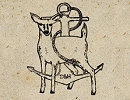Contact Seller
Doe And Hope
Tel07729 213013Please quote Antiques Atlas.


 Antique Sofreh (dining Kilim).
Antique Sofreh (dining Kilim).
 Elm Three Tier Dumb Waiter c.1960
Elm Three Tier Dumb Waiter c.1960
 Antique Turkish Konya Yastik.Early 19th Century
Antique Turkish Konya Yastik.Early 19th Century
 Early Antique Tekke Turkmen Turkoman Chuval Face.
Early Antique Tekke Turkmen Turkoman Chuval Face.
 Set Antique Yuruk Nomadic Saddle Bags (heybe).
Set Antique Yuruk Nomadic Saddle Bags (heybe).
 Complete Set Of Very Rare Antique Saddle Bags
Complete Set Of Very Rare Antique Saddle Bags
 Antique Tribal Qashqai Horse Blanket Cover.
Antique Tribal Qashqai Horse Blanket Cover.
 Early Tribal Khamseh Bag Face. Khorjin Saddle Bag
Early Tribal Khamseh Bag Face. Khorjin Saddle Bag
 Bronze And Ormolu Neoclassical Campana Urns
Bronze And Ormolu Neoclassical Campana Urns
 Antique Leather Ship Fire Bucket George III Monogram
Antique Leather Ship Fire Bucket George III Monogram
 American Prisoner Art Diorama Monkey Saloon Bar
American Prisoner Art Diorama Monkey Saloon Bar
 18th Century French Country Winery Beam Spike
18th Century French Country Winery Beam Spike
Non UK callers :
+44 7729 213013
A Rare Primitive Antique Vampire Slaying Kit


The weighty primitive stained pine box, formerly an ammunition case, being compartmentalised with recessed carrying handles and applied pine and iron Christian Cross to its top with paper label image of Jesus Christ to the interior with a further applied label reading ‘Oh Lord Be Thou My Guide’, the hinged cover opening to reveal a pastiche of items associated with the killing of vampires, dating from the middle of the nineteenth century up to the first quarter of the twentieth century, the wholes assimilation surviving from the turn of the century.
The kit comprises two oak and iron stakes, a heavy fourteen inch nineteenth century oak and iron banded mallet with primitive figural carving, two nineteenth century books to include a leather bound 1847 Italian Prayer book ‘Giardino di divozione’ and an 1851 marbled paper and leather bounded Christian devotional book ‘De Imitatione Christi’ (The Imitation of Christ) by Thomas à Kempis, an early twentieth century set of rosary beads with heart shaped cartouche reading ‘Pro Deo Et Hibernia’ (For God and Ireland) with one compartment having been solely used for the burning of candles and as such it is full of melted wax. The four bottles in the kit include a c.1900 holy water glass bottle with suspended metal cross in the solution and corked top with applied paper labels showing the human skeleton, a curios carved bone phial with incised carving and corked top, a small late nineteenth century glass phial with pontil mark and corked top containing garlic powder and a c.1900 heavy, square shouldered, glass bottle with applied paper label of the human skull and with unusual waxed sealed top, the glass containing a silvery metal substance, quite possibly a pure silver nugget pertaining to when the Greek goddess Artemis cursed the first vampire so that his skin burned when it touched silver.
The compendium is in seemingly complete order with no apparent losses, and is a primitive example of a rare novelty item. We have not attempted to clean, restore or repair any elements of the kit and it remains in as found condition. The items are dirty and we have not tried to open any of the bottles.
More elaborate slaying kits that have surfaced in recent years have featured Corpus Christies and pistols. The box, as a former ammunition box, is stamped to the reverse “Small Arms Ammunition Metallic Cartridges Made in The USA, Western Cartridge company East Alton, Ill. USA”. This helps us to date it more precisely, with the rather crude construction making it relatively early for a box of its type. The Western Cartridge Company was founded in 1898, it was the forerunner of the Olin Corporation, formed in 1944, of which Western is still a subsidiary, and is based in East Alton, Illinois, USA. In about 1902, Franklin Olin co-operated with the Austin Cartridge Company of Cleveland, Ohio to launch a small plant on the grounds of the Western Cartridge Company to produce metallic cartridges and blasting caps. This box dates to that time, so approximately 1902-1905. The construction of the mallet is mid nineteenth century and the patination on the handle is superb, as is the fascinating carving of the figure on the handle. We feel the kit is refreshingly honest in that it is, in parts, a genuine antiquity and there is no deliberate ageing or replacement parts in it that one finds in more expensive, sometimes fraudulent, kits.
Many of the vampire slaying kits on the market have been attributed to Professor Ernst Blomberg and Nicholas Plomdeur, who worked in the early-to-mid 19th century. These are generally regarded as novelty or tourist vampire slaying kits that were produced for tourist purposes before 1900. It is often unclear whether kits such as this are antique examples or more contemporary assemblies of old replacement parts.
Vampire legends go back thousands of years and occur in great variety in almost every culture around the world. The vampires we are most familiar with today are largely based on Eastern European legends, which originated in the far East and were transported with trade caravans that traveled along the silk route to the Mediterranean. This slaying kit was the height of novelty in late Victorian England, the fascination, in part, rising from Bram Stoker’s Dracula of 1897.
Who was doomed to become a vampire? A person born with a caul or tail, the illegitimate offspring of two illegitimate persons or anyone who died an unnatural death or before being baptised. Also doomed were witches, the seventh child of the same sex in a family, the child of a pregnant woman who was looked at by a vampire or who did not eat salt, those bitten by vampires and those not properly buried.
Precautions to prevent vampirism included burying the body face down, placing a wild, thorny rose on the grave to repel unholy spirits or piling stones to obstruct the demon from rising from the earth. Spreading millet, grains or poppy seeds at the gravesite would distract the vampire, and the smell of garlic buried with the corpse would repel it. Eucharistic symbols of purity or holiness, such as the host wafer and salt, also repelled the demons, and holy water could sear its flesh and, if sprinkled in the grave, sterilized the vampire’s tomb. Holes that appeared in the earth at the gravesite might signal the presence of a vampire, and graves were often opened seven years after death to ensure against vampirism. Corpses that had not decomposed or whose eyes were open were often deemed to be a vampire. Other telltale signs included a ruddy complexion with the mouth and nails clotted with blood, or the corpse floating on a reservoir of blood. If the flesh was punctured with a pin, blood would gush from the body.
"Even a flawless pedigree will not ensure anyone against the intrusion into his family vault, since every person killed by a nosferatu becomes likewise a vampire after death and will continue to suck the blood of innocent people till the spirit has been exorcised, either by opening the grave of the person suspected and driving a stake through the corpse, or firing a pistol shot into the coffin. In very obstinate cases, it is further recommended to cut off the head and replace it in the coffin with the mouth filled with garlic, or to extract the heart and burn it, strewing the ashes over the grave."
Excerpted from an 1885 essay, Transylvania Superstitions by Emily Gerard, and read by Bram Stoker.
Although awkward to date as a whole with real certainty, this assemblage is a truly fascinating find and is surely the true king of the novelty throne. It proves a hugely interesting and primitive macabre artifact and one that equally fascinates and captivates, positively dripping with morbid intrigue… all with the faint tang of garlic wafting through the air.
SellerDoe And Hope
View all stock from
Doe And Hope

 Private dealer, By appointment only
Private dealer, By appointment only
The Onion Barn, Shoe Cottage,
15 High Street, Blunham,
Bedfordshire, MK44 3NL.
MK44 3NL
Tel : 07729 213013
Non UK callers : +44 7729 213013
Get directions to Doe And Hope
The kit comprises two oak and iron stakes, a heavy fourteen inch nineteenth century oak and iron banded mallet with primitive figural carving, two nineteenth century books to include a leather bound 1847 Italian Prayer book ‘Giardino di divozione’ and an 1851 marbled paper and leather bounded Christian devotional book ‘De Imitatione Christi’ (The Imitation of Christ) by Thomas à Kempis, an early twentieth century set of rosary beads with heart shaped cartouche reading ‘Pro Deo Et Hibernia’ (For God and Ireland) with one compartment having been solely used for the burning of candles and as such it is full of melted wax. The four bottles in the kit include a c.1900 holy water glass bottle with suspended metal cross in the solution and corked top with applied paper labels showing the human skeleton, a curios carved bone phial with incised carving and corked top, a small late nineteenth century glass phial with pontil mark and corked top containing garlic powder and a c.1900 heavy, square shouldered, glass bottle with applied paper label of the human skull and with unusual waxed sealed top, the glass containing a silvery metal substance, quite possibly a pure silver nugget pertaining to when the Greek goddess Artemis cursed the first vampire so that his skin burned when it touched silver.
The compendium is in seemingly complete order with no apparent losses, and is a primitive example of a rare novelty item. We have not attempted to clean, restore or repair any elements of the kit and it remains in as found condition. The items are dirty and we have not tried to open any of the bottles.
More elaborate slaying kits that have surfaced in recent years have featured Corpus Christies and pistols. The box, as a former ammunition box, is stamped to the reverse “Small Arms Ammunition Metallic Cartridges Made in The USA, Western Cartridge company East Alton, Ill. USA”. This helps us to date it more precisely, with the rather crude construction making it relatively early for a box of its type. The Western Cartridge Company was founded in 1898, it was the forerunner of the Olin Corporation, formed in 1944, of which Western is still a subsidiary, and is based in East Alton, Illinois, USA. In about 1902, Franklin Olin co-operated with the Austin Cartridge Company of Cleveland, Ohio to launch a small plant on the grounds of the Western Cartridge Company to produce metallic cartridges and blasting caps. This box dates to that time, so approximately 1902-1905. The construction of the mallet is mid nineteenth century and the patination on the handle is superb, as is the fascinating carving of the figure on the handle. We feel the kit is refreshingly honest in that it is, in parts, a genuine antiquity and there is no deliberate ageing or replacement parts in it that one finds in more expensive, sometimes fraudulent, kits.
Many of the vampire slaying kits on the market have been attributed to Professor Ernst Blomberg and Nicholas Plomdeur, who worked in the early-to-mid 19th century. These are generally regarded as novelty or tourist vampire slaying kits that were produced for tourist purposes before 1900. It is often unclear whether kits such as this are antique examples or more contemporary assemblies of old replacement parts.
Vampire legends go back thousands of years and occur in great variety in almost every culture around the world. The vampires we are most familiar with today are largely based on Eastern European legends, which originated in the far East and were transported with trade caravans that traveled along the silk route to the Mediterranean. This slaying kit was the height of novelty in late Victorian England, the fascination, in part, rising from Bram Stoker’s Dracula of 1897.
Who was doomed to become a vampire? A person born with a caul or tail, the illegitimate offspring of two illegitimate persons or anyone who died an unnatural death or before being baptised. Also doomed were witches, the seventh child of the same sex in a family, the child of a pregnant woman who was looked at by a vampire or who did not eat salt, those bitten by vampires and those not properly buried.
Precautions to prevent vampirism included burying the body face down, placing a wild, thorny rose on the grave to repel unholy spirits or piling stones to obstruct the demon from rising from the earth. Spreading millet, grains or poppy seeds at the gravesite would distract the vampire, and the smell of garlic buried with the corpse would repel it. Eucharistic symbols of purity or holiness, such as the host wafer and salt, also repelled the demons, and holy water could sear its flesh and, if sprinkled in the grave, sterilized the vampire’s tomb. Holes that appeared in the earth at the gravesite might signal the presence of a vampire, and graves were often opened seven years after death to ensure against vampirism. Corpses that had not decomposed or whose eyes were open were often deemed to be a vampire. Other telltale signs included a ruddy complexion with the mouth and nails clotted with blood, or the corpse floating on a reservoir of blood. If the flesh was punctured with a pin, blood would gush from the body.
"Even a flawless pedigree will not ensure anyone against the intrusion into his family vault, since every person killed by a nosferatu becomes likewise a vampire after death and will continue to suck the blood of innocent people till the spirit has been exorcised, either by opening the grave of the person suspected and driving a stake through the corpse, or firing a pistol shot into the coffin. In very obstinate cases, it is further recommended to cut off the head and replace it in the coffin with the mouth filled with garlic, or to extract the heart and burn it, strewing the ashes over the grave."
Excerpted from an 1885 essay, Transylvania Superstitions by Emily Gerard, and read by Bram Stoker.
Although awkward to date as a whole with real certainty, this assemblage is a truly fascinating find and is surely the true king of the novelty throne. It proves a hugely interesting and primitive macabre artifact and one that equally fascinates and captivates, positively dripping with morbid intrigue… all with the faint tang of garlic wafting through the air.
Price The price has been listed in British Pounds.
Conversion rates as of 12/DEC/2024. Euro & Dollar prices will vary and should only be used as a guide.
Always confirm final price with dealer. Phone or visit the website to buy, Free UK shipping.
DimensionsWidth 18 inches
Height 7.5 inches
Depth 12 inches
Weight 7.5 KGS
Date c.1847-1910
Late Victorian Antiques Material Pine
Origin British
Condition Good.
Item code as155a900
Status Sold
£2400.00 
$3045.60 
€2907.84 

$

€

Conversion rates as of 12/DEC/2024. Euro & Dollar prices will vary and should only be used as a guide.
Always confirm final price with dealer. Phone or visit the website to buy, Free UK shipping.
View all stock from
Doe And Hope

 Private dealer, By appointment only
Private dealer, By appointment onlyThe Onion Barn, Shoe Cottage,
15 High Street, Blunham,
Bedfordshire, MK44 3NL.
MK44 3NL
Tel : 07729 213013
Non UK callers : +44 7729 213013
Get directions to Doe And Hope
You may also be interested in
 Antique Sofreh (dining Kilim).
Antique Sofreh (dining Kilim).
 Elm Three Tier Dumb Waiter c.1960
Elm Three Tier Dumb Waiter c.1960
 Antique Turkish Konya Yastik.Early 19th Century
Antique Turkish Konya Yastik.Early 19th Century
 Early Antique Tekke Turkmen Turkoman Chuval Face.
Early Antique Tekke Turkmen Turkoman Chuval Face.
 Set Antique Yuruk Nomadic Saddle Bags (heybe).
Set Antique Yuruk Nomadic Saddle Bags (heybe).
 Complete Set Of Very Rare Antique Saddle Bags
Complete Set Of Very Rare Antique Saddle Bags
 Antique Tribal Qashqai Horse Blanket Cover.
Antique Tribal Qashqai Horse Blanket Cover.
 Early Tribal Khamseh Bag Face. Khorjin Saddle Bag
Early Tribal Khamseh Bag Face. Khorjin Saddle Bag
 Bronze And Ormolu Neoclassical Campana Urns
Bronze And Ormolu Neoclassical Campana Urns
 Antique Leather Ship Fire Bucket George III Monogram
Antique Leather Ship Fire Bucket George III Monogram
 American Prisoner Art Diorama Monkey Saloon Bar
American Prisoner Art Diorama Monkey Saloon Bar
 18th Century French Country Winery Beam Spike
18th Century French Country Winery Beam Spike








